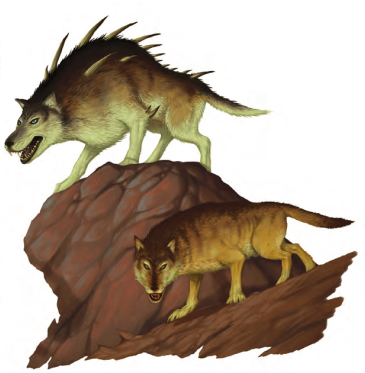Let's Read the 4e Monster Manual/Vault: Wolves

This article is part of a series! Click here to see the other entries.
Wolves are real animals and have been part of the game since its beginnings. Here, they are both in the Monster Manual and in the Monster Vault’s animal appendix.
The Lore
Real-world wolves are pack hunters, and the ancestors of modern dogs. If I recall correctly they mostly stay away from people and only attack when cornered or really desperate. There are enough stories about wolves attacking sheep and other farm animals that it must have happened in the past, but it’s not really a common occurrence any more. And that’s partly because there are very few wolves left in the real world.
D&D wolves are of course a lot more common and a lot more willing to attack people, since a pack of wolves is a classic low-level wilderness encounter. They can be found across a wide variety of climates and terrains. Mountains? Check! Forests? Check! Plains? Check! Deserts? Why not?
This being D&D, there might be some natural landscapes where your reasonably realistic grey wolf might have trouble competing with the more fantastical and powerful monsters common to the game. Instead, these places might feature dire wolves, which are a larger, smarter and more dangerous variety. As of 3e, they’re also spikier.
In addition to being found in the wild, both common and dire wolves might be trained by humanoids such as goblins or shifters, who have a knack for taming wolves directly without having to spend centuries turning them into dogs. Other creatures might also control large packs of them through magic: vampires are famous for this.
The Numbers
Wolves are obviously Natural Beasts, even the dire variety. They have low-light vision, and their other acute senses are represented by Trained Perception. They run at speed 8, attack with bites and usually do something interesting when they have combat advantage.
Gray Wolf (Both)
Gray wolves are Medium, and Level 2 Skirmishers with 38 HP. As far as natural wolves go, it seems to me these would be on the large end of the scale, which might explain why they’re more eager to attack humans than you’d expect a mundane wolf to be.
Their sole attack is the bite, which does extra damage against prone targets. The bite in the MV version also allows the wolf to shift 4 squares as an effect, so these critters will never stay still if they can help it.
If a wolf has Combat Advantage against a target, its bite will also knock the target prone on a hit. This means a group of wolves has a lot of incentive to flank a specific PC. One of them knocks the victim prone with its first bite, the others pile on with that bonus bite damage. All of them keep moving around with those free shifts. And now you know why they call this “wolf-pack tactics”!
Dire Wolf (Both)
Dire wolves are Large, which means each is roughly horse-sized. They’re Level 5 Skirmishers with the Mount keyword and 67 HP.
Dire wolf bites have larger numbers due to them being higher level, and also do increased damage to prone targets. They also knock the target prone if the wolf has combat advantage against the target, and the monsters have more ways to get that other than plain old flanking.
The text for “combat advantage” in the MM version says the dire wolf has CA against any target who has at least one other ally adjacent to it. No flanking required. This could be interpreted to mean that a dire wolf with a rider always has CA against any enemy adjacent to it! The MV version of this trait, named Pack Harrier, says it only works when the wolf has two or more allies adjacent to the enemy. So the rider still counts, but you need a second ally to get the bonus.
They also have a trait called Pack Hunter, which grants their rider combat advantage if an ally other than the mount is adjacent to the target. So if you go with the MV text, the rider would get CA whenever the wolf got it, and vice-versa.
I’m guessing that the MV version is the “correct” one in all aspects here. A wolf that got permanent combat advantage against everyone would be a little overpowered due to that knockdown effect on the bite.
Sample Encounters and Final Impressions
We have two sample encounters here:
-
Level 3: 3 gray wolves, 2 hobgoblin archers, and 1 hobgoblin warcaster. Your standard hunting party.
-
Level 5: 3 dire wolves, and 2 longtooth shifter hunters. A mounted hunting party.
Werewolves are also quite likely to be leading dire wolf packs, and Count Strahd in the original Ravenloft module quite famously commanded a literal army of dire wolves he could send after the PCs every night until they entered his castle.
Dire wolf-riding goblins are also a classic image, though the levels are a little mismatched as printed. It would be easy enough to level the goblins up or the dire wolves down, and it’s quite plausible for the Small goblins to be riding Medium gray wolves instead of the Large dire ones.
These days “you’re attacked by a pack of wolves while on the road” strikes me as a little uninspired, though I think they’re OK when used as muscle by sapient opposition.